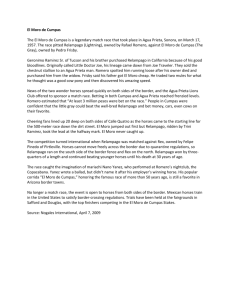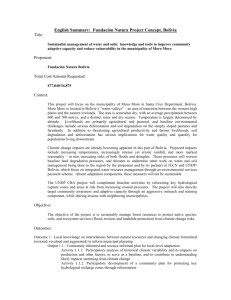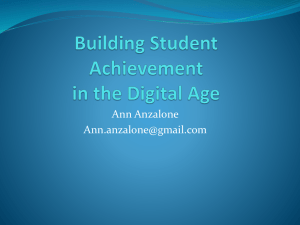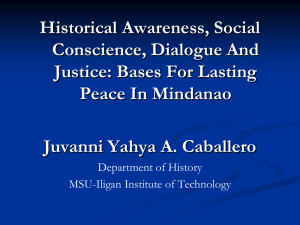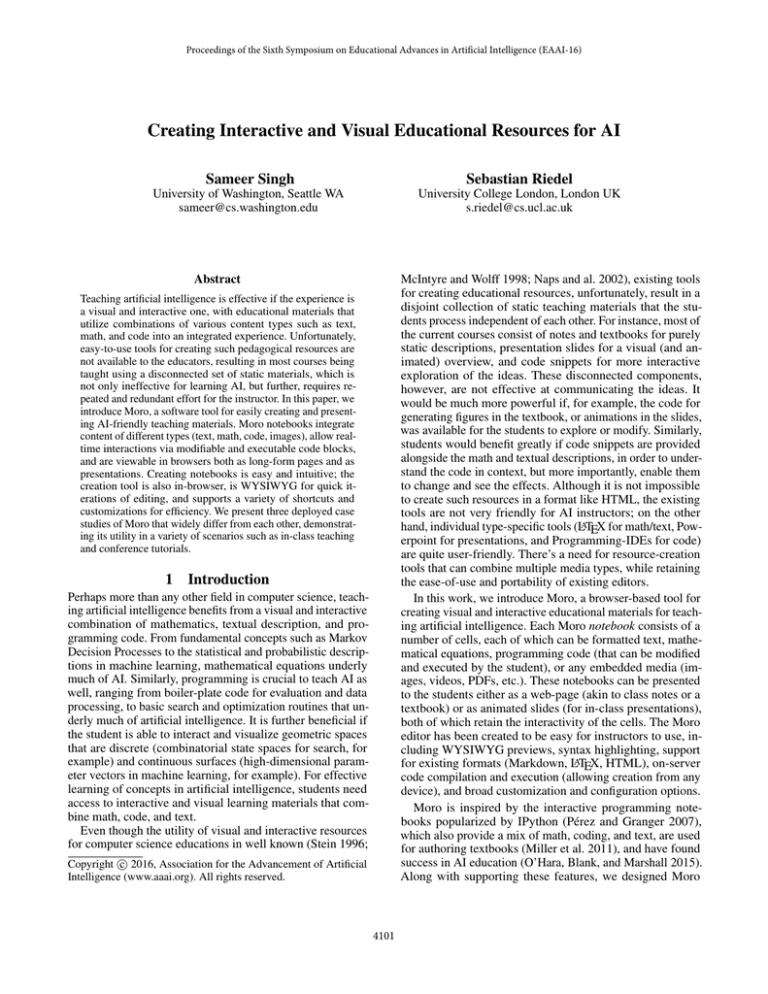
Proceedings of the Sixth Symposium on Educational Advances in Artificial Intelligence (EAAI-16)
Creating Interactive and Visual Educational Resources for AI
Sameer Singh
Sebastian Riedel
University of Washington, Seattle WA
sameer@cs.washington.edu
University College London, London UK
s.riedel@cs.ucl.ac.uk
McIntyre and Wolff 1998; Naps and al. 2002), existing tools
for creating educational resources, unfortunately, result in a
disjoint collection of static teaching materials that the students process independent of each other. For instance, most of
the current courses consist of notes and textbooks for purely
static descriptions, presentation slides for a visual (and animated) overview, and code snippets for more interactive
exploration of the ideas. These disconnected components,
however, are not effective at communicating the ideas. It
would be much more powerful if, for example, the code for
generating figures in the textbook, or animations in the slides,
was available for the students to explore or modify. Similarly,
students would benefit greatly if code snippets are provided
alongside the math and textual descriptions, in order to understand the code in context, but more importantly, enable them
to change and see the effects. Although it is not impossible
to create such resources in a format like HTML, the existing
tools are not very friendly for AI instructors; on the other
hand, individual type-specific tools (LATEX for math/text, Powerpoint for presentations, and Programming-IDEs for code)
are quite user-friendly. There’s a need for resource-creation
tools that can combine multiple media types, while retaining
the ease-of-use and portability of existing editors.
In this work, we introduce Moro, a browser-based tool for
creating visual and interactive educational materials for teaching artificial intelligence. Each Moro notebook consists of a
number of cells, each of which can be formatted text, mathematical equations, programming code (that can be modified
and executed by the student), or any embedded media (images, videos, PDFs, etc.). These notebooks can be presented
to the students either as a web-page (akin to class notes or a
textbook) or as animated slides (for in-class presentations),
both of which retain the interactivity of the cells. The Moro
editor has been created to be easy for instructors to use, including WYSIWYG previews, syntax highlighting, support
for existing formats (Markdown, LATEX, HTML), on-server
code compilation and execution (allowing creation from any
device), and broad customization and configuration options.
Moro is inspired by the interactive programming notebooks popularized by IPython (Pérez and Granger 2007),
which also provide a mix of math, coding, and text, are used
for authoring textbooks (Miller et al. 2011), and have found
success in AI education (O’Hara, Blank, and Marshall 2015).
Along with supporting these features, we designed Moro
Abstract
Teaching artificial intelligence is effective if the experience is
a visual and interactive one, with educational materials that
utilize combinations of various content types such as text,
math, and code into an integrated experience. Unfortunately,
easy-to-use tools for creating such pedagogical resources are
not available to the educators, resulting in most courses being
taught using a disconnected set of static materials, which is
not only ineffective for learning AI, but further, requires repeated and redundant effort for the instructor. In this paper, we
introduce Moro, a software tool for easily creating and presenting AI-friendly teaching materials. Moro notebooks integrate
content of different types (text, math, code, images), allow realtime interactions via modifiable and executable code blocks,
and are viewable in browsers both as long-form pages and as
presentations. Creating notebooks is easy and intuitive; the
creation tool is also in-browser, is WYSIWYG for quick iterations of editing, and supports a variety of shortcuts and
customizations for efficiency. We present three deployed case
studies of Moro that widely differ from each other, demonstrating its utility in a variety of scenarios such as in-class teaching
and conference tutorials.
1
Introduction
Perhaps more than any other field in computer science, teaching artificial intelligence benefits from a visual and interactive
combination of mathematics, textual description, and programming code. From fundamental concepts such as Markov
Decision Processes to the statistical and probabilistic descriptions in machine learning, mathematical equations underly
much of AI. Similarly, programming is crucial to teach AI as
well, ranging from boiler-plate code for evaluation and data
processing, to basic search and optimization routines that underly much of artificial intelligence. It is further beneficial if
the student is able to interact and visualize geometric spaces
that are discrete (combinatorial state spaces for search, for
example) and continuous surfaces (high-dimensional parameter vectors in machine learning, for example). For effective
learning of concepts in artificial intelligence, students need
access to interactive and visual learning materials that combine math, code, and text.
Even though the utility of visual and interactive resources
for computer science educations in well known (Stein 1996;
c 2016, Association for the Advancement of Artificial
Copyright Intelligence (www.aaai.org). All rights reserved.
4101
directly for AI education: it provides a growing library of
AI data structures for visualization, and supports full interactions on the client-side without requiring the students to
install Moro.
Moro notebooks are being created for a number of different
types of instruction materials; we explore a few case studies
in the paper (§3). First, we demonstrate the use of Moro as
conventional online documentation for the W OLFE probabilistic programming language that consists of introductory
materials for probabilistic graphical models, optimization,
and a number of demo applications of the language (spanning NLP, computer vision, and relational learning). Second,
Moro is being used as the course material of graduate-level
statistical natural language processing, presented as an interactive textbook for exploring various concepts such as
NLP tasks (language models, parsing, etc.) and approaches
(classification, structured prediction, learning, etc.). Finally,
we also present the materials for the ACL1 2015 conference
tutorial that consisted of substantial mathematical definitions,
animated figures, and interactive code for topics such as
matrix/tensor factorization and stochastic gradient descent.
These case studies, together, demonstrate the flexibility of
Moro as a tool for teaching a variety of artificial intelligence
concepts, for very different audiences.
2
Text: Markdown Since text is clearly the most frequently
used content type in almost all types of educational materials,
we want creators to be able to easily write richly-formatted
text without necessarily using a fairly complex language
like LATEX or HTML2 . Instead, we use Markdown (Gruber
2004), an intuitive syntax that supports all kinds of basic
text formatting (bold, italics, links, lists, etc.), along with
features that AI instructors appreciate such as inline math
using LATEX, images, code blocks, and so on. Consequently,
text cells in Moro are much more aesthetically pleasing than
just unformatted text.
Math: LATEX Since mathematical equations are fundamental to most topics in artificial intelligence, LATEX (Lamport
1994) has been widely adopted by the field. The math cells in
Moro also use the LATEX syntax, allowing authors to write set
of equations as easily as they would when authoring papers.
Since Moro is browser-based, it uses an external library for
rendering LATEX in HTML (Cervone et al. 2009) that supports
features such as equation numbering and labeled references
from other cells.
Programming: Interactive Code Many of the crucial concepts in artificial intelligence can be effectively conveyed by
programming, which is why most AI courses contain substantial programming components. Allowing students to read and
modify code is one of the most important teaching tools available to the AI educators, however this practice has mostly
been restricted to assignments. To take the next step of bringing interactive code to the classroom, or to incorporate it
into the course materials, educational resources need to support two crucial components: (1) Visualization: the output
of executing code blocks should be visually engaging, such
as images, animations, plots, etc. instead of plain text print
statements, and (2) Interaction: users should be able to modify code and regenerate the output as quickly as possible, for
instance the instructor presenting modifications in-class, or
student trying their own changes when learning.
This is the core functionality of Moro that differentiates it
from existing content creation tools, and makes it suitable for
AI educators. Moro notebooks can contain cells with program
code3 . The code in these cells is executed (on a remote server)
at a click of a button, and the output is rendered immediately
in the notebook itself. In order to encourage visually engaging
output, the results of the code execution is HTML, thus allowing instructors to easily create visual and richly-formatted
representations (Moro currently provides implementations
for common data structures used in AI such as matrices as images, directed and undirected graphs, line/scatter/bar charts,
search trees, graphical models, NLP annotations, and others).
This combination of remote execution of code and HTML
rendering of data structures is a powerful combination that
enables instructors to create educational resources containing
fully interactive programming content.
Visual and Interactive Moro Notebooks
The main unit of educational resources in Moro is a notebook. Each Moro notebook is similar to a single chapter in
a textbook or a set of slides that cover a single topic. In this
section, we present details on the different components of a
notebook, and how they come together to create an interactive
and visual teaching resource.
2.1
Notebooks
Each Moro notebook consists of a sequence of cells, where
each cell can contain content only of a single type. We describe the different content types supported in Moro in the
next section. This sequence of cells is used for laying out and
formatting the content as the creator intends, for example a
single slide in a Moro presentation often contains multiple
cells. Although each cell is edited independently and can be
moved around, they are not completely independent since, for
instance, cells that contain code implicitly import the code
from all previous code cells. Notebooks are not the highest
level of organization in Moro, often multiple notebooks are
used by creators, that are organized in a folder hierarchy that
is presented within Moro in an intuitive manner.
2.2
Types of Cells
As described above, a cell is the smallest unit of content in
Moro, and contains content of a single media type, similar
to a paragraph or a set of equations. Along with a number of
basic content types that we describe next, Moro also supports
additional layout cells that define the document organization,
for instance the section and sub-section dividers.
2
Although Moro supports those as well.
Moro currently supports Scala (Odersky and al. 2004), a functional language popular in machine learning and NLP, but extensions
to other languages is planned. It is worth mentioning that IPython
also supports Scala (Archambault 2015).
3
1
Annual Meeting of the Association of Computational Linguistics, top NLP conference with more than 300 papers in 2015.
4102
3.1
Other Types Although the content types so far cover a
majority of what AI educators need, we don’t want them to
be constrained in any way when creating their materials. To
this end, Moro supports almost limitless customizability and
extensibility via cells that can inject arbitrary HTML and
Javascript code into the notebooks. Further, we also provide
an embedded viewer that supports many file types such as
PDFs, videos, audio, Office documents, and so on. That said,
we anticipate these features to be only used rarely.
2.3
Creators: Sebastian Riedel, Tim Rocktäschel, Sameer Singh,
Luke Hewitt, Jason Naradowsky
Link: http:// www.wolfe.ml
W OLFE is a probabilistic programming language that can
be used to declaratively define machine learning models and
optimization approaches, thus allowing deployment of sophisticated algorithms even by people unfamiliar with artificial
intelligence (Riedel et al. 2014). Moro has been used to create tutorial documentation for the language, which includes
not only the syntax of the language, but also explanation of
the underlying machine learning concepts (see Figure 1 for
screenshots). Even though online documentation does not
usually fall into the standard view of teaching, the interactive nature of the code, and the combination of math, text,
and rendered output, made these Moro notebooks perfect
tools for teaching both the language and machine learning.
The feedback from the users has been quite positive, especially the interactive exploration of factor graphs (as shown
in Figure 1a) provided useful insights into conditional independencies in complex probability distributions.
Viewing Notebooks
Education materials are consumed and presented primarily
in two different modes: (1) as reference reading material
for individual students, and (2) as a slide deck presented
to an audience by the instructor. We support these modes
by allowing every Moro notebook to be viewed either as a
long-form document, or as a presentation. Any overhead in
installing viewers for education materials can be an obstacle
to learning, and requires more effort on the instructors part,
thus we want to make the notebooks as easy as possible
for students to view. We take a browser-centric, lightweightclient approach, allowing Moro notebooks to be viewed (and
as we will see later, created) on any device capable of running
a modern browser, including phones and tablets, both as longform documents and as presentations. Another advantage of
having browser-based layout is that Moro notebooks can be
further customized by the instructor, if desired, using CSS.
3.2
Case II: Statistical NLP Course Material
Creators: Sebastian Riedel, Matko Bošnjak, Tim Rocktäschel
Link: github.com/ uclmr/ stat-nlp-book
The second use case we present here is a graduate-level
course on statistical natural language processing that covers NLP tasks (such as tagging and dependency parsing),
machine learning methods (such as linear chain CRFs and
matrix factorization), and optimization (such as dynamic programming and gradient descent). Moro is used for creating
an online textbook for the course, with a notebook for each
chapter (see the screenshot in Figure 2). Not only is Moro
able to recreate a similar formatting as a book, but further, the
interactivity provided by the code cells allows the students to
not only observe the code behind all the illustrative examples,
but also modify the example and regenerate the figures right
in the textbook.
Long-form Document View In this view of a notebook,
all the cells of the notebook are laid out sequentially, one
after the other. The resulting output is similar to textbooks,
class notes, or online reference web-pages. However, the code
cells are still interactive, allowing modification and execution
by each viewer of the notebook independently, i.e. multiple
students can make their own edits and executions to the same
notebook. Further, in the rare case offline access required,
this view is also printer-friendly and supports export to static
document formats like PDF.
Presentation View When teaching a large audience, such
as in a classroom, notebooks can also be viewed as a presentation. Moro uses a browser-based presentation library
(Hattab 2011) in order to support this, which provides features as slide animations, transition animations, keyboard
shortcuts, overview, themes, touch control, speaker view, and
so on. Further, even the presentation view supports interactive programming, allowing the presenter to modify code and
regenerate output during the presentation.
3
Case I: W OLFE Documentation and Demos
3.3
Case III: ACL 2015 Tutorial
Creators: Guillaume Bouchard, Jason Naradowsky, Sebastian Riedel, Tim Rocktäschel, and Andreas Vlachos
Link: github.com/ uclmr/ acl2015tutorial
As a final example, we consider the use case of presentation
to a large audience, specifically the ACL 2015 tutorial on
“Matrix and Tensor Factorization Methods for Natural Language Processing” that was presented on July 26, 2015 in
Beijing, China to the conference attendees. The presentation
view of Moro was used to created the slides for the entirety
of the 3.5 hour long tutorial, which contained a combination
of equations, text, figures, and code as shown in Figure 3.
Mixing these different content types in the same editor was
found to be useful by the tutorial presenters, and the ability to
modify code during the presentation allowed the presenters
to investigate novel teaching strategies that would not have
been possible when using conventional presentation tools.
The attendees felt that they benefited from the interactivity,
and appreciated the ability to download and replay the slides
on their own after the tutorial.
Examples of Moro Use Cases
In this section, we demonstrate some of the variety in scenarios of teaching in artificial intelligence for which Moro has
been used to create educational materials. The case studies
described here vary considerably, ranging from conventional
course material, to online documentation, and to a conferencestyle tutorial. Through these case studies, we will explore the
utility of Moro in allowing instructors to cover a variety of
topics in artificial intelligence, explore different visual and
interactive elements in their presentations, and flexibility and
customizability of Moro notebooks to different mediums.
4103
(b) Another section of the documentation showing a mixture of
math and text, with a tree representation of data structures. The
students can not only regenerate the tree by modifying the code,
but the visualization itself supports interactions such as panning
and zooming to navigate more complex trees.
(a) Interactive page with a combination of code and the visualization of the factor graph generated by the code. The students can
modify the mathematical definition of the model, and explore
how it translates into conditional independences.
Figure 1: W OLFE Machine Learning Toolkit Documentation
4
Creating Notebooks
4.2
Since the cell editor (left-side) is the where the content creators are likely to spend most of their time, we’ve introduced
a number of features for further ease-of-use. The editors support a wide variety of regular text-editing keyboard shortcuts,
along with extra ones specific to Moro such as navigating
between previous/next cells, regenerating the output of the
current cell, changing the content type of the cell, splitting
the cell, and so on. Each cell editor also adapts to the content
type, using the appropriate syntax highlighting and autocompletion, making them quite similar to popular editors of
the specific content type.
So far, we have highlighted the various features of Moro
notebooks that make it useful for teaching AI, and studied
a few examples of how Moro is being used today. However,
often adoption of any format depends crucially on its ease of
use, more so in teaching since the instructors differ considerably in their backgrounds and expertises. With this in mind,
Moro notebook editor has been created to be extremely easy
to use: it uses WYSIWYG4 UI principles to give an accurate representation of the notebook, uses syntax highlighting
and keyboard shortcuts customized to each content type, and
supports browser-based interface and a portable file format
for easy creation on any device. A screenshot of the Moro
notebook editor, shown in Figure 4, highlights many of these
features, which we will also elaborate upon next.
4.1
4.3
File Format and Portability
The underlying format of Moro notebooks is JSON (ECMA
2013), a human readable (and editable) format for structured
data. Using this text-based format not only integrates with
revision control systems and external text-friendly editors,
but also opens up the possibilities of interfacing with other
systems using existing JSON libraries. Further, since only the
cell content is stored, and not the actual rendered HTML, the
Moro notebooks are quite small in size, and thus portable.
WYSIWYG Interface
The editor interface is laid out with the cell editors on the left
(text fields for entering the content), and the rendered version
of the cell displayed on the right. As the author changes the
content of the cell, for example entering Markdown in the
first cell in Figure 4, Moro renders the output immediately on
the right. This constant rendering allows instructors to detect
errors and iterate quickly on the content. Further, the conversion of the cell code to HTML is carried out remotely on the
server, thus requiring minimal computational requirements
from the client’s browser.
4
Cell Editors
4.4
Installation
A difficult and complicated installation of tools causes an
unnecessary overhead for the student’s learning, and requires
additional effort on the instructor’s part to provide support.
We have attempted to make Moro quite easy to install; on any
Linux/Unix shell, including OSX and Cygwin on Windows,
Moro can be installed and run as a web-server using 2 − 3
“What You See Is What You Get”
4104
(a) Slide with combination of text, figures, and equations
Figure 2: A section of the statistical NLP graduate course
material showing math, text, and code, where the bar chart
has been generated directly from the code, and thus can
be modified. Data used to generate the distribution appears
earlier in the notebook.
lines of code. Note that the installation is required primarily
for creating, editing, and displaying notebooks; in many instances only the instructor needs to set up this server, and the
students are able to view notebooks on any browser.
5
(b) Slide with interactive code block, modifying which during
the presentation generates different output matrices.
Conclusions and Future Work
We are motivated by the need for interactive and visual educational materials for teaching AI that are effective pedagogical resources (Stein 1996; McIntyre and Wolff 1998;
Naps and al. 2002), however are extremely difficult to create
using existing tools. To address this concern, we propose
Moro, an in-browser creation and presentation tool that allows instructors to easily create such visual and interactive
pages. In particular, Moro notebooks allow instructors to
combine together math, text, and images with interactive
code blocks that visualize AI data structures. We highlighted
three use cases of Moro that cover different modes of AI education: course material, online documentation, and tutorial
presentation. Moro source code, along with the case studies,
is open source at http://wolfe-pack.github.io/moro under the
BSD license.
There are a number of future avenues we plan to explore. To increase the coverage of instructors with different programming backgrounds, we would like to expand the
programming languages that Moro supports. Given Moro’s
REST-ful API, we do not anticipate this to be a significant
challenge. We are also going to investigate data structure
visualizations commonly used in teaching artificial intelligence beyond the ones currently supported by Moro (matrices, graphs, trees, plate models, and plots), including popular
Figure 3: Slides from the ACL 2015 Tutorial
application-specific structures such as the grid-world and
computer vision (Moro currently supports NLP tasks). Finally, we are actively seeking feedback from Moro users
(students and instructors), and plan to improve Moro continuously to incorporate their suggestions.
Acknowledgements
The authors would like to thank Tim Rocktäschel, Luke
Hewitt, Jason Naradowsky, Guillaume Bouchard, Matko
Bošnjak, Andreas Vlachos, and Vivek Srikumar for ideas,
testing, and bug reports for early versions of Moro. This work
was supported in part by TerraSwarm, one of six centers of
STARnet, a Semiconductor Research Corporation program
sponsored by MARCO and DARPA, in part by the Paul Allen
Foundation through an Allen Distinguished Investigator grant
and in part by a Marie Curie Career Integration Fellowship.
4105
Figure 4: Moro Notebook Editor: Screenshot of the Moro notebook creation interface, with some of the features such as
WYSIWYG interface, cell mode selection, cell and notebook configuration, etc. highlighted in purple.
References
gramming Language. Technical Report IC/2004/64, EPFL,
Lausanne, Switzerland.
O’Hara, K.; Blank, D.; and Marshall, J. 2015. Computational
notebooks for AI education. In Florida Artificial Intelligence
Research Society Conference.
Pérez, F., and Granger, B. E. 2007. IPython: A system for
interactive scientific computing. Computing in Science and
Engineering 9(3).
Riedel, S.; Singh, S.; Srikumar, V.; Rocktaschel, T.; Visengeriyeva, L.; and Noessner, J. 2014. Wolfe: Strength reduction and approximate programming for probabilistic programming. In International Workshop on Statistical Relational AI
(StarAI).
Stein, L. A. 1996. Interactive programming: Revolutionizing
introductory computer science. ACM Comput. Surv. 28(4es).
Archambault, A. 2015. Jupyter Scala. https://github.com/
alexarchambault/jupyter-scala. [Online; accessed 30-Nov2015].
Cervone, D.; Sorge, V.; Perfect, C.; and Krautzberger, P. 2009.
MathJax. https://www.mathjax.org/. [Online; accessed 15Sep-2015].
ECMA. 2013. The JSON Data Interchange Format. Technical
Report 404, ECMA Standards.
Gruber, J. 2004. Daring Fireball - Markdown. http:
//daringfireball.net/projects/markdown/syntax. [Online; accessed 15-Sep-2015].
Hattab, H. E. 2011. reveal.js - The HTML Presentation
Framework. http://lab.hakim.se/reveal-js/. [Online; accessed
15-Sep-2015].
Lamport, L. 1994. LATEX: a Document Preparation System.
Reading, Ma.: Addison-Wesley Publishing Company, 2 edition. Illustrations by Duane Bibby.
McIntyre, D. R., and Wolff, F. G. 1998. An experiment with
WWW interactive learning in university education. Computers & Education 31(3):255 – 264.
Miller, B.; Ranum, D.; Guzdial, M.; Ericson, B.; and Thakur,
V. 2011. Runestone Interactive. http://www.interactivepython.
org/runestone. [Online; accessed 30-Nov-2015].
Naps, T. L., and al. 2002. Exploring the role of visualization
and engagement in computer science education. In Working
Group Reports from ITiCSE on Innovation and Technology in
Computer Science Education, ITiCSE-WGR ’02, 131–152.
New York, NY, USA: ACM.
Odersky, M., and al. 2004. An Overview of the Scala Pro-
4106

